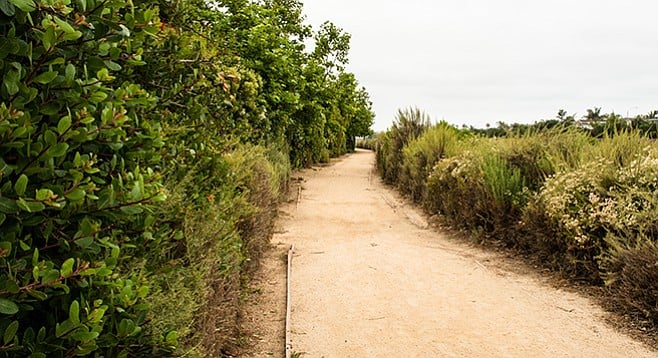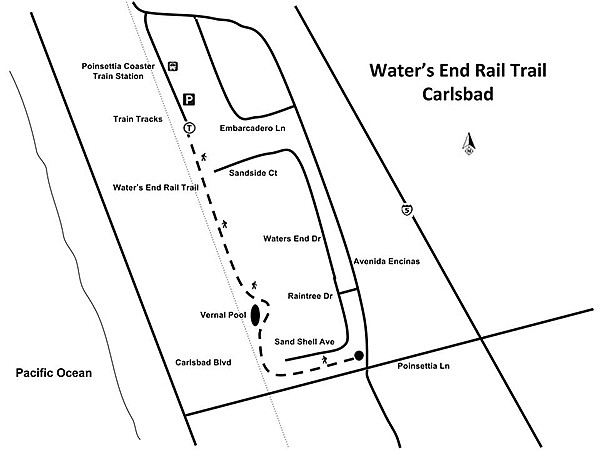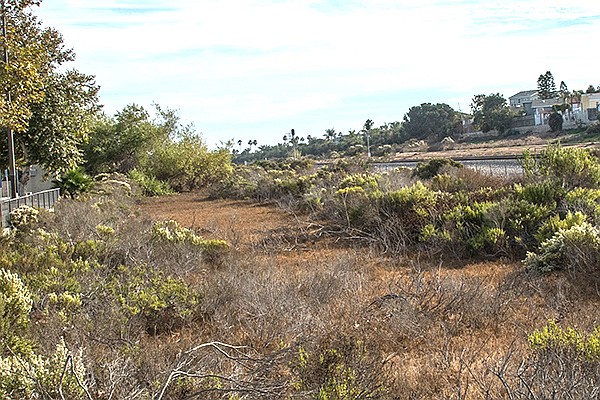 Facebook
Facebook
 X
X
 Instagram
Instagram
 TikTok
TikTok
 Youtube
Youtube

The Coastal Rail Trail is projected to become a continuous path following the Coaster commuter train line from Oceanside to San Diego. As of 2017, only discontinuous segments exist. The Water’s End Trail in Carlsbad is one of these Coastal Rail Trail segments.

In addition to being a good place for a short walk, it is of considerable interest as one of the few remaining areas of vernal pools in San Diego County, most of which have been bulldozed for developments. Vernal pools are unique biological habitats typically containing rare and endangered plants and animals. Organisms living here must be able to tolerate extended periods of drought as well as periodic flooding.

These shallow pools fill with water after heavy rains in the spring, but they only contain standing water for one to two months. In this brief time, San Diego fairy shrimp (Branchinecta sandiegoensis) hatch and flourish, providing food for the San Diego spadefoot toads (Spea harmondii) that have been hibernating in the clay beneath the pond for a minimum of months, and possibly years.
As the pools dry up, they will become barren areas of cracked adobe clay. But, before this occurs, there is a brief period in which short-cycling plants such as San Diego mesa mint (Pogogyne abramsii) and button celery (Eryngium aristulatum) can germinate, flower, and complete their life cycle, utilizing the remaining soil moisture before it, too, is gone as the long drought of the summer and fall progresses. Before beginning your hike from your parked car toward the trailhead, walk over to the train station and look south from the southern-most path to the train platform. From this path, you will have a clear view of the vernal pool area to the south. Once you are on the trail itself, the vernal pools will largely be obscured by the dense growth of native vegetation along the trail.
The trailhead at the southwestern end of the parking area will appear almost as a tunnel through sycamore trees and large toyon and other shrubs that mark the path and have grown profusely along the eastern side of the trail. Most of these were planted when the trail was constructed. The western side of the trail contains a wild profusion of native shrubs, including goldenbush, black sage, lemonadeberry, California buckwheat and California sagebrush, among others. The vernal pools are on the other side of this narrow but dense border.
After walking about half a mile on this well-maintained decomposed granite path, make a left turn as the trail continues for another quarter of a mile to the intersection of Poinsettia Lane and Avenida Encinas where the trail ends. Return to your vehicle the way you came.
This segment of the Coastal Rail Trail features vernal pools
Distance from downtown San Diego: 31 miles (allow about 35 minutes). Follow CA-163N to I-805N, and then to I-5N. Take exit 45 on I-5N at Poinsettia Lane and head west, toward the ocean. Almost immediately, make a right turn on Avenida Encinas and continue for about 0.75 mile to the Poinsettia Coaster Train Station on the left. Enter the station and park in an available space. Start walking south from your parked car toward the trailhead at the southwest corner of the station.
Hiking length: About 1.5 miles round trip. Allow up to 1 hour.
Difficulty: Easy. Bicycles and leashed dogs allowed on the trail. Wheelchair accessible.


The Coastal Rail Trail is projected to become a continuous path following the Coaster commuter train line from Oceanside to San Diego. As of 2017, only discontinuous segments exist. The Water’s End Trail in Carlsbad is one of these Coastal Rail Trail segments.

In addition to being a good place for a short walk, it is of considerable interest as one of the few remaining areas of vernal pools in San Diego County, most of which have been bulldozed for developments. Vernal pools are unique biological habitats typically containing rare and endangered plants and animals. Organisms living here must be able to tolerate extended periods of drought as well as periodic flooding.

These shallow pools fill with water after heavy rains in the spring, but they only contain standing water for one to two months. In this brief time, San Diego fairy shrimp (Branchinecta sandiegoensis) hatch and flourish, providing food for the San Diego spadefoot toads (Spea harmondii) that have been hibernating in the clay beneath the pond for a minimum of months, and possibly years.
As the pools dry up, they will become barren areas of cracked adobe clay. But, before this occurs, there is a brief period in which short-cycling plants such as San Diego mesa mint (Pogogyne abramsii) and button celery (Eryngium aristulatum) can germinate, flower, and complete their life cycle, utilizing the remaining soil moisture before it, too, is gone as the long drought of the summer and fall progresses. Before beginning your hike from your parked car toward the trailhead, walk over to the train station and look south from the southern-most path to the train platform. From this path, you will have a clear view of the vernal pool area to the south. Once you are on the trail itself, the vernal pools will largely be obscured by the dense growth of native vegetation along the trail.
The trailhead at the southwestern end of the parking area will appear almost as a tunnel through sycamore trees and large toyon and other shrubs that mark the path and have grown profusely along the eastern side of the trail. Most of these were planted when the trail was constructed. The western side of the trail contains a wild profusion of native shrubs, including goldenbush, black sage, lemonadeberry, California buckwheat and California sagebrush, among others. The vernal pools are on the other side of this narrow but dense border.
After walking about half a mile on this well-maintained decomposed granite path, make a left turn as the trail continues for another quarter of a mile to the intersection of Poinsettia Lane and Avenida Encinas where the trail ends. Return to your vehicle the way you came.
This segment of the Coastal Rail Trail features vernal pools
Distance from downtown San Diego: 31 miles (allow about 35 minutes). Follow CA-163N to I-805N, and then to I-5N. Take exit 45 on I-5N at Poinsettia Lane and head west, toward the ocean. Almost immediately, make a right turn on Avenida Encinas and continue for about 0.75 mile to the Poinsettia Coaster Train Station on the left. Enter the station and park in an available space. Start walking south from your parked car toward the trailhead at the southwest corner of the station.
Hiking length: About 1.5 miles round trip. Allow up to 1 hour.
Difficulty: Easy. Bicycles and leashed dogs allowed on the trail. Wheelchair accessible.
Comments